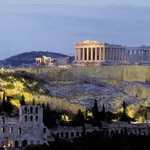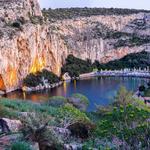

Things To Do

Acropolis
Few sights in the world compare to Athens' Acropolis, with its Parthenon temple perched high on a rocky crag keeping watch over centuries of civilization. A reminder of the glory of ancient Athens, the Acropolis was the center of the ancient city and functioned as a citadel in its protected hilltop location. The most emblematic building is the Parthenon, the largest temple of the classical antiquity period dating from 447 BC to 338 BC. For beautiful views of the Acropolis from below, head to the north side of the hill. Streetside restaurants line the pedestrian street of Apostolou Pavlou and look up to the Acropolis. Some of these restaurants also have rooftop dining, with incredible views across to the Acropolis, showing the grand entrance, the Temple of Athena Nike, and the Parthenon, all of which are lit up in the evenings.
Athens Archaeological Museum
Athens' National Archaeological Museum is the largest archaeological museum in Greece and one of the greatest antiquities museums in the world. The museum is housed in an impressive Neoclassical building with 8,000 square meters of exhibition space. On display are five permanent collections with more than 11,000 exhibits, offering a comprehensive overview of Greek civilization from prehistory through the classical period to late antiquity.
Plaka
Between the northern slopes of the Acropolis and Ermoú Street, the picturesque Pláka neighborhood is a tourist hot spot. The main attraction of this historic area is its charming village ambience. Narrow pedestrian streets and the cheerful little squares of the Pláka quarter are lined with lovely bougainvillea-trimmed pastel-painted houses, restaurants, and shops. Tucked away in peaceful corners of the neighborhood are historic churches, such as the Metamórfosis Church in the southwest and the Church of Kapnikaréa in the north. A leisurely stroll through the picturesque setting is the perfect thing to do when you've had your fill of ruins and museums.
Temple of Olympian Zeus
Dedicated to Zeus, the Temple of Olympian Zeus, also called the Olympieion, was the largest temple in ancient Greece. Though the Parthenon is better preserved, the Temple of Olympian Zeus was an even more monumental structure in its day. The temple dates to the sixth century BC but was not completed until the second century AD by the Emperor Hadrian. In front of the Olympieion, not far from the entrance, stands Hadrian's Arch at the end of Dionysiou Areopagitou. It's easy to imagine the grand impression this temple made in its complete form. More than a hundred enormous marble columns once supported the grandiose sanctuary. Only 15 columns remain standing, and another surviving column lies on the ground, but the ruins' monumental presence gives a sense of the massive size of the original building. The gigantic structure was a befitting shrine to Zeus, the ancient Greeks' most all-powerful God, known as the King of Gods.

Natural Spring Spa Vouliagmeni Lake
Vouliagmeni Lake in the heart of the Athenian Riviera, is the hidden treasure of Attica’s nature. Situated on an idyllic landscape, a rare geological phenomenon is included in NATURA 2000 network. Its brackish waters, rich in salts and minerals, have a temperature between 22o-29o degrees all year roundand meets the requirementsof EXCELLENT category. Waters are continuously replenished by the sea and the underground thermal springs, 50 to 100 meters deep, offer a natural and unique thermal spa experience. Swimming in the lake is more than pleasurable, it’s a holistic experience stimulating the swimmers’ energy and balancing their wellness. The Garra Rufa fish – known as spa fish –are part of the ecosystem. Sunbeds and umbrellas are offered around the Lake’s shoreline. An all-day restaurant offers a culinary experience. Prive Area promises moments of lavishness and complete relaxation. Lifeguarding/medical services, Parking, Cabins, Lockers, Showers, Accessibility, Wi – Fi, Kids corner.